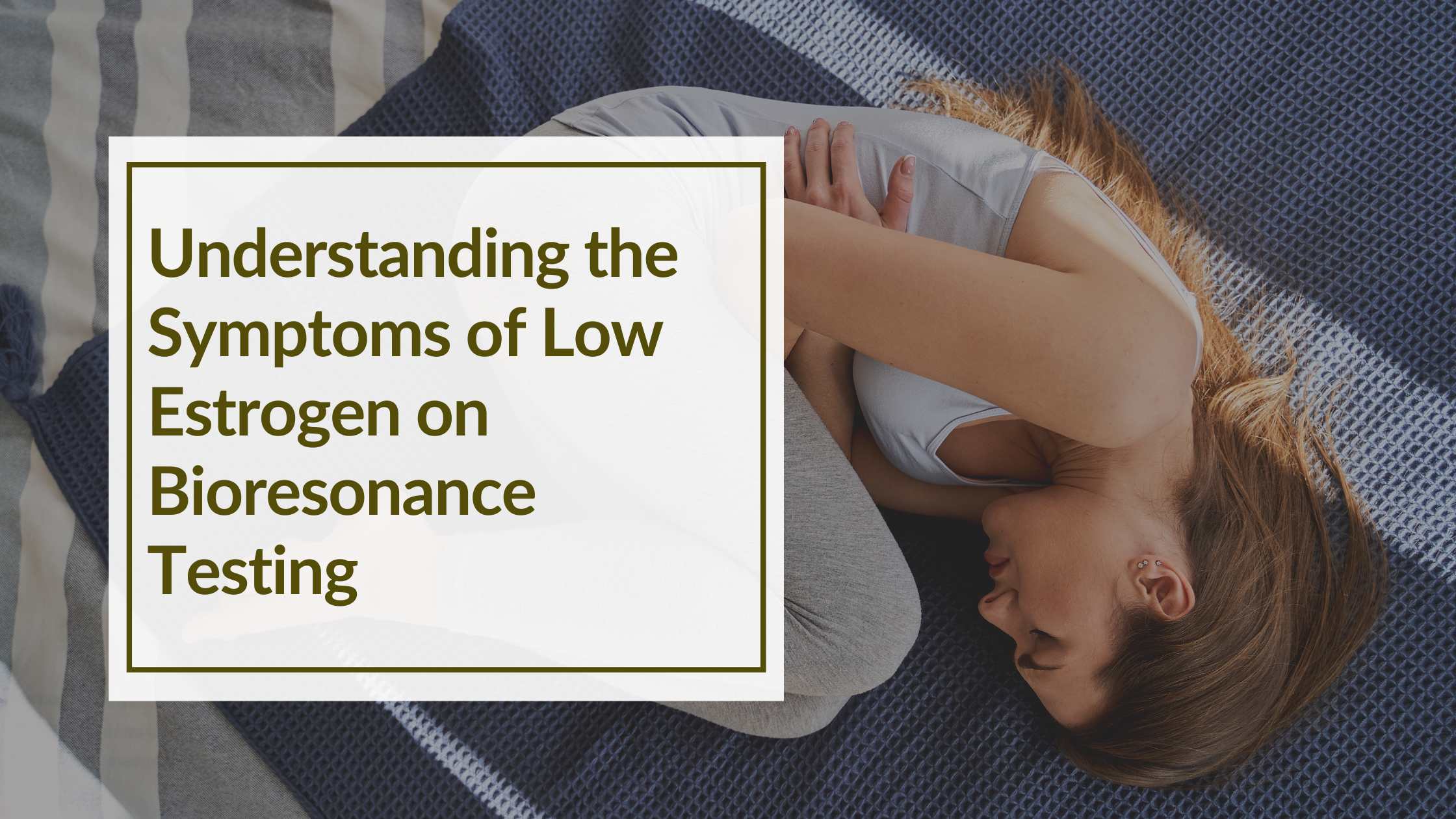
Do You Think You Have Symptoms of Low Estrogen?
Estrogen is a group of sex hormones that play a key role in the development and regulation of the female reproductive system. Men also have estrogen playing a role in their sex hormone profile.
Estrogens are primarily produced in the ovaries, which is part of the Urogenital System on a Full Scan home health test. Smaller amounts are produced by the adrenal glands and fat cells, and these organs become more significant in life stages such as menopause and andropause.
There are three primary types of estrogen: estradiol, estriol, and estrone.
- Estradiol: the most potent and prevalent in women of childbearing age.
- Estrone: estrone becomes the dominant estrogen.
- Estriol: primarily produced during pregnancy.
For the purposes of bioresonance scanning, we look to see whether estrogen resonates as low, or high. Hormone function is governed by other systems, like the Nervous System, and working on the whole body can help your hormones feel more balanced!
The significance of estrogen extends much further than reproduction, or understanding low estrogen. The impact of estrogen is felt across numerous bodily systems, including the Locomotor System, and the Urogenital System. For both men and women, a lack of estrogen can impact overall health.
Estrogen levels naturally fluctuate over time. Extreme drops or sustained low levels may mean that a particular body system needs support. This can mean your Nervous System, or your Digestive System on your CBH Energetics bioenergetic test.
Role of Estrogen in the Body
Before you can understand the symptoms of low estrogen and determine if this might be what you are experiencing, it’s helpful to cover the several roles estrogen plays in the body. Its primary function is to regulate the menstrual cycle and prepare the uterus for pregnancy. That’s just the influence of estrogen in the reproductive system.
It also affects the brain, bones, heart, skin, and other tissues.
Estrogen helps maintain healthy bones by working in tandem with calcium, Vitamin D, and other hormones to break down and rebuild bones according to the body’s natural processes. Fluctuations of estrogen affect bone formation (1). This may show up ion a bioenergetic scan in the Locomotor System or in Joints.
It also plays a partial role in maintaining cardiovascular health by helping to regulate cholesterol levels and promoting artery health. Sex hormones in general may have an influence in the risk of cardiovascular disease (2). If you guessed that this could influence the Cardio dial on a test report, you would be correct!
Additionally, estrogen affects mood and cognitive health, with low levels often linked to mood swings and cognitive issues. Estrogen highs, and lows, are common in perimenopause, and into menopause.
Causes of Low Estrogen
Low estrogen levels can result from a variety of causes. We already discussed natural life transitions, such as menopause, which are a common cause. During perimenopause, the ovaries gradually produce less estrogen, leading to a variety of symptoms. Eventually, in menopause, the ovaries stop releasing eggs, resulting in significantly lower estrogen levels.
This is where the adrenal glands step in to help, and where that abdominal weight gain comes in to play. Fatty tissue is a source of estrogen. Fat could be labeled an organ, as it has hormonal properties! Fatty tissue is one of the points that may come up stressed on a Full Scan, and be related to toxins, or aging.
Certain health issues can also cause low estrogen. These include things affecting the pituitary gland, which controls hormone production, and conditions such as polycystic ovary syndrome (PCOS). The pituitary gland makes 9 different hormones! Follicle Stimulating Hormone (FSH) and Luteinizing Hormone (LH) are made by the pituitary, and play a role in low estrogen.
FSH is secreted by the pituitary to stimulate the ovarian follicles to produce estrogen. If the pituitary is stressed, and your report shows low FSH, then you might also see low estrogen. Luteinizing hormone is activated in mid cycle by increased estrogen and this triggers ovulation. Lower estrogen will have an impact on ovulation.
Furthermore, extreme exercise, eating disorders, and significant weight loss can disrupt the body’s hormone production and lead to low estrogen levels. This is because the pituitary is affected with extreme exercise and it stops signaling the ovaries to ovulate. Low body weight can also affect estrogen levels. The female body will ALWAYS prioritize survival over reproduction. These behaviours will alter the hormonal processes in the body and affect fertility, the menstrual cycle, and even the thyroid.
Bioenergetic stress links to look for on a CBH report include: Pituitary and Pineal, Hypothalamus, Digestive Stress, Nervous System Stress, Urogenital Stress, Joints, Teeth and Jaw, Locomotor Stress, Adrenals.
Surgery, including removal of ovarian cysts and complete hysterectomies will affect estrogen levels.
Common Symptoms of Low Estrogen
The symptoms of low estrogen can vary greatly depending on the individual and the cause of the decreased levels. That said, some symptoms are more common than others. These include irregular periods, mood swings, hot flashes, night sweats, and insomnia.
Sounds like high estrogen, doesn’t it?
Physical changes can also occur, such as dry skin, thinning hair, and a decrease in breast fullness. Furthermore, low estrogen levels can lead to more frequent urinary tract infections due to changes in the urinary tract (this is where that Urogenital Stress can show up on a CBH report). Some individuals may also experience a decrease in libido.
Low estrogen also affects collegen production, and this also has an effect on the Urogenital System with increased UTI’s.
How Low Estrogen Affects Women’s Health
These symptoms of low estrogen can have a profound effect on a woman’s health. Prolonged low estrogen levels can lead to osteoporosis, a condition characterized by weakened, brittle bones. This may show up on a CBH Full Scan Report as Locomotor Stress, or Joints.
This is because estrogen plays a significant role in bone health, and a lack of it can disrupt the body’s natural process of breaking down and rebuilding bone.
In addition to osteoporosis, low estrogen levels can increase the risk of heart disease. Estrogen helps maintain the flexibility of arterial walls, and a deficiency can lead to stiffening of the arteries and subsequent cardiovascular issues. Does a stressed Cardiovascular dial on a CBH report mean that you have heart disease? No, it does not.
Bioenergetics does not work like that, and we do not diagnose with bioenergetic testing.
Brain health is also a symptom of low estrogen and has been associated with an increased risk of dementia and other cognitive disorders.
How to Identify Symptoms of Low Estrogen
Identifying the signs of low estrogen can be challenging, as many of the symptoms overlap with other health issues. However, if you’re experiencing a combination of the common symptoms mentioned above, and particularly if you’re in the age range for perimenopause or menopause, it may be worthwhile to explore the possibility of low estrogen.
It’s also important to note that symptoms can vary in severity. Some people may have a minor decrease in estrogen levels and experience severe symptoms, while others with significantly reduced levels may exhibit only mild symptoms.
Conventional Diagnosing Low Estrogen Levels
The diagnosis of low estrogen levels typically involves a two-step process: a thorough medical history and a blood test. The medical history will include a discussion of your symptoms, menstrual history, and overall health. It may also involve questions about lifestyle factors that could affect estrogen levels, such as diet, exercise, and stress levels.
The blood test is used to measure the levels of estrogen in your blood. Sometimes, other hormones that interact with estrogen, like progesterone, may also be measured to provide a more comprehensive picture of your hormonal health. Blood testing is always good information to have.
Is this enough? Blood tests are necessary, however we forget that they are a snapshot of what is circulating in the bloodstream at the time. To maintain balance, the body will always make sure that blood levels stay stable. How do we understand how something like estrogen is interacting with cells?
Where estrogen is considered, a blood test is not taking into consideration how the liver is breaking down estrogen. There are different detoxification pathways that estrogen can take, after being converted in the liver.
Options for testing include bioenergetic scanning, saliva and urine testing.
Supporting Symptoms of Low Estrogen
For some people, lifestyle changes such as a balanced diet and regular (less strenuous) exercise may be enough to help increase estrogen levels. For others, supplementation, and yes, medication, may be necessary, especially in menopause.
Hormone replacement therapy (HRT) is the most common treatment for low estrogen. This involves taking medication that contains estrogen to replace the hormones your body is lacking. However, HRT is not suitable for everyone and can have side effects, so it’s important to discuss this option thoroughly with a licensed healthcare provider.
Certain foods are known to be rich in phytoestrogens, plant compounds that can mimic the effect of estrogen in the body. These include soy products, flax seeds, and certain fruits and vegetables. The controversy over foods, and what we should eat, is getting louder. If you have concerns about your food sensitivity section on your report, please consider booking a 30 minute consultation with one of our practitioners.
Stress management is important, as chronic stress can disrupt the balance of hormones in your body. Techniques such as yoga, meditation, and deep breathing can help manage stress levels. Ensuring you get enough sleep is also important, as sleep disruption can negatively impact hormone production. All of this positively impacts the Nervous System, which works with your hormones in the Endocrine System!

Top takeaways for symptoms of low estrogen and bioresonance testing
Knowing the symptoms of low estrogen is one step towards shifting your hormones to a more balanced state.
Supporting your Digestive System, which houses the estrobolome, is one factor in hormonal balance. The estrobolome is a collection of bacteria in the gut, or digestive system that helps metabolize estrogen. If you see digestive stress on a CBH Full Scan, supporting your Digestive System will help with hormone imbalances, like low estrogen.
Liver stress is another connection to symptoms of low estrogen, or high estrogen. The liver has two phases of detoxification, Phase 1 and Phase 2. In the first phase, a process called hydroxylation converts estrogen into three potential metabolites, to move to Phase 2 for better and more efficient detoxification.
This is where foods from the brassica family can support estrogen detoxification by the liver. Foods include cauliflower, rapini, cabbage, broccoli, bok choy, and brussels sprouts come in! These support the Phase 1 part of liver detoxification. In Phase 2, foods that contain B Vitamins, along with choline and magnesium are needed.
If you see liver stress on your Full Scan, along with imbalances in Vitamin B12, Folate (B9), Choline, Riboflavin (B2) or Pyridoxine (B6) may energetically relate to Phase 2 of liver detoxification.
Lastly, seeing the Adrenal Glands show stress bioenergetically may mean that they have taken over to make estrogen when the ovaries stop functioning. Your adrenals, and your Nervous System may need a little TLC.
Homeopathic remedies such as Hormone Combination or Endo Code F (or Endo Code M for men!) can help with low estrogen and estrogen imbalances.
By staying informed about your hormonal health and seeking professional help when needed, you can navigate the challenges of low estrogen and help you on your quest of creating balanced health.
Our Full Scan, and Balancing Scan will assess your bioenergetic hormones with your hair and saliva samples. See a Full Scan Report here.
